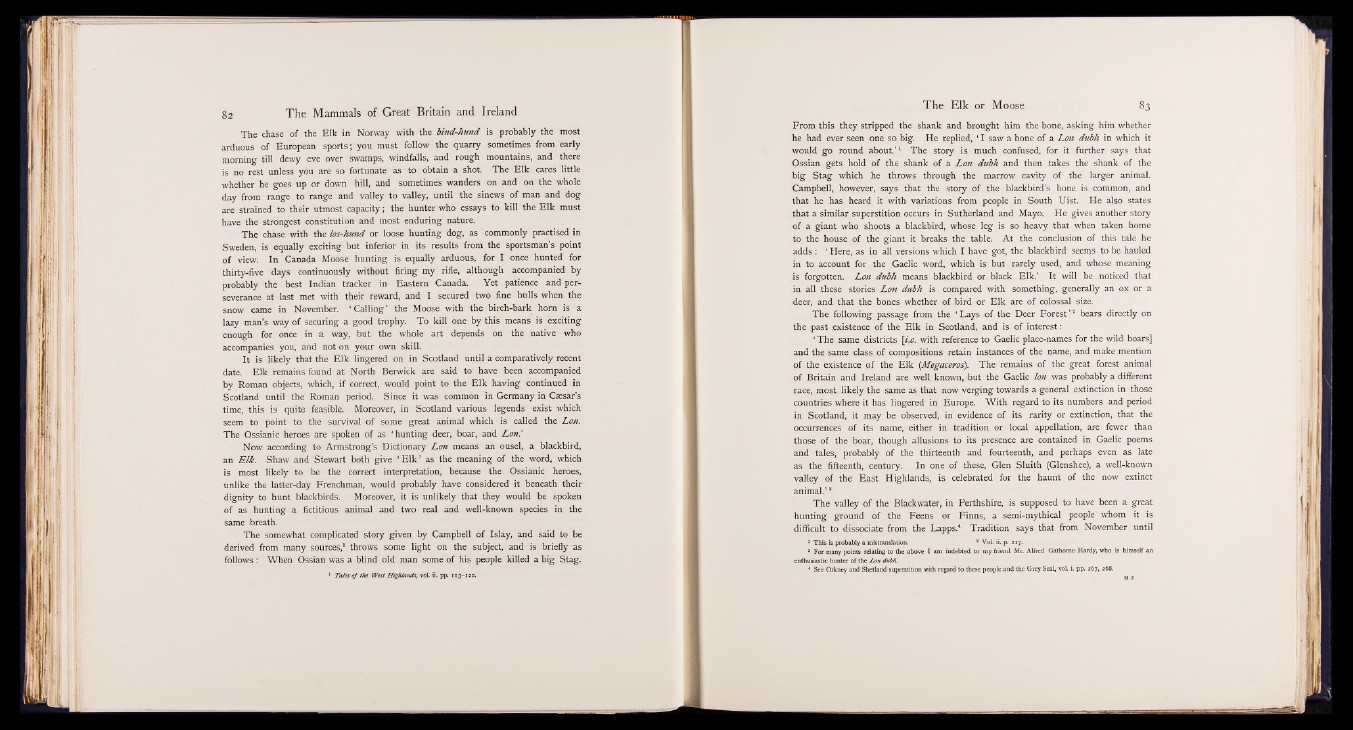
The chase of the Elk in Norway with the bind-hund is probably the most
arduous of European sports; you must follow the quarry sometimes from early
morning till dewy eve over swamps, windfalls, and rough mountains, and there
is no rest unless you are so fortunate as to obtain a shot. The Elk cares little
whether he goes up or down hill, and sometimes wanders on and on the whole
day from range to range and valley to valley, until the sinews of man and dog
are strained to their utmost capacity; the hunter who essays to kill the Elk must
have the strongest constitution and most enduring nature.
The chase with the los-hund or loose hunting dog, as commonly practised in
Sweden, is equally exciting but inferior in its results from the sportsman’s point
of view. In Canada Moose hunting is equally arduous, for I once hunted for
thirty-five days continuously without firing my rifle, although accompanied by
probably the best Indian tracker in Eastern Canada. Yet patience and perseverance
at last met with their reward, and I secured two fine bulls when the
snow came in November. ‘ Calling' the Moose with the birch-bark horn is a
lazy man’s way of securing a good trophy. To kill one by this means is exciting
enough for once in a way, but the whole art depends on the native who
accompanies you, and not on your own skill.
It is likely that the Elk lingered on in Scotland until a comparatively recent
date. Elk remains found at North Berwick are said to have been accompanied
by Roman objects, which, if correct, would point to the Elk having continued in
Scotland until the Roman period. Since it was common in Germany in Caesar's-
time, this is quite feasible. Moreover, in Scotland various legends exist which
seem to point to the survival of some great animal which is called the Lon.
The Ossianic heroes are spoken of as ‘ hunting deer, boar, and Lott.'
Now according to Armstrong’s Dictionary Lon means an ousel, a blackbird,
an E lk . Shaw and Stewart both give ‘ Elk ’ as the meaning of the word, which
is most likely to be the correct interpretation, because the Ossianic heroes,
unlike the latter-day Frenchman, would probably have considered it beneath their
dignity to hunt blackbirds. Moreover, it is unlikely that they would be spoken
of as hunting a fictitious animal and two real and well-known species in the
same breath.
The somewhat complicated story given by Campbell of Islay, and said to be
derived from many sources,1 throws some light on the subject, and is briefly as
follows : When Ossian was a blind old man some of his people killed a big Stag.
Tales o f the West Highlands, vol. ii. pp. 113-120.
From this they stripped the shank and brought him the bone, asking him whether
he had ever seen one so big. He replied, ‘ I saw a bone of a Lon dubh in which it
would go round about.’ \ The story is much , confused, for it further says that
Ossian gets hold of the shank of a Lon dubh and then takes the shank of the
big Stag which he throws through the marrow cavity of the larger animal.
Campbell, however, says that the story of the blackbird’s bone is common, and
that he has heard it with variations from people in South Uist. He also states
that a similar superstition occurs in Sutherland and Mayo. He gives another story
of a giant who shoots a blackbird, whose leg is so heavy that when taken home
to the house of the giant it breaks the table. At the conclusion of this tale he
adds : ‘ Here, as in all versions which I have got, the blackbird seems to be hauled
in to account for the Gaelic word, which is but rarely used, and whose meaning
.is forgotten. Lon dubh means blackbird or black Elk.’ It will be noticed that
in all these stories Lon dubh is compared with something, generally an ox or a
deer, and that the bones whether of bird or Elk are of colossal size.
The following passage from the ‘ Lays of the Deer Forest’ 2 bears directly on
the past existence of the Elk in Scotland, and is of interest:
‘ The same districts [i.e. with reference to Gaelic place-names for the wild boars]
and the same class of compositions retain instances of the name, and make mention
of the existence of the Elk (Megaceros). The remains of the great forest animal
of Britain and Ireland are well known, but the Gaelic Ion was probably a different
race, most likely the same as that now verging towards a general extinction in those
countries where it has lingered in Europe. With regard to its numbers and period
in Scotland, it may be observed, in evidence of its rarity or extinction, that the
occurrences of its name, either in tradition or local appellation, are fewer than
those of the boar, though allusions to its presence are contained in Gaelic poems
and tales, probably of the thirteenth and fourteenth, and perhaps even as late
as the fifteenth, century. In one of these, Glen Sluith (Glenshee), a well-known
valley of the East Highlands, is celebrated for the haunt of the now extinct
animal.’ 8
The valley of the Blackwater, in Perthshire, is supposed to have been a great
hunting ground of the Feens or Finns, a semi-mythical people whom it is
difficult to dissociate from the Lapps.4 Tradition says that from November until
This is probably a mistranslation. * Vol. ii. p. 217.,
3 For many points relating to the above I am indebted to my friend Mr. Alfred Gathome-Hardy, who is himself an
enthusiastic hunter of the Lon dubh.
* See Orkney and Shetland superstition with regard to these people and the Grey Seal, vol. i. pp. 267, 268.